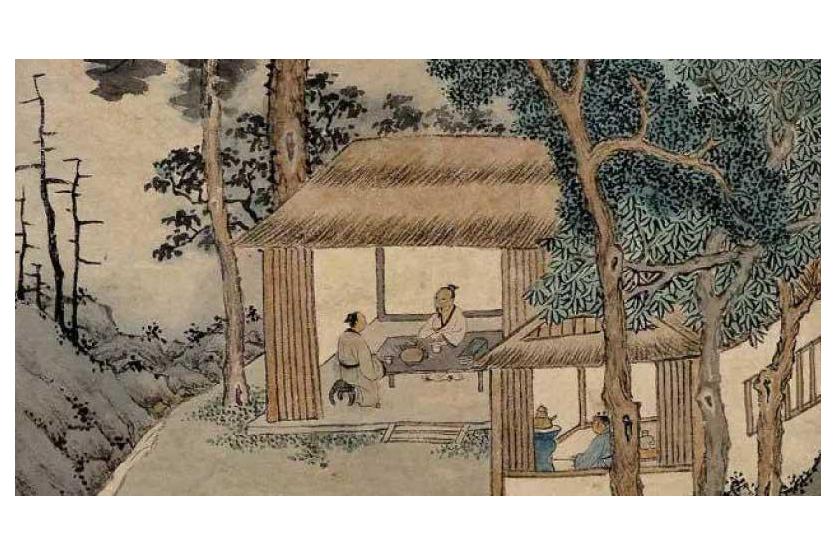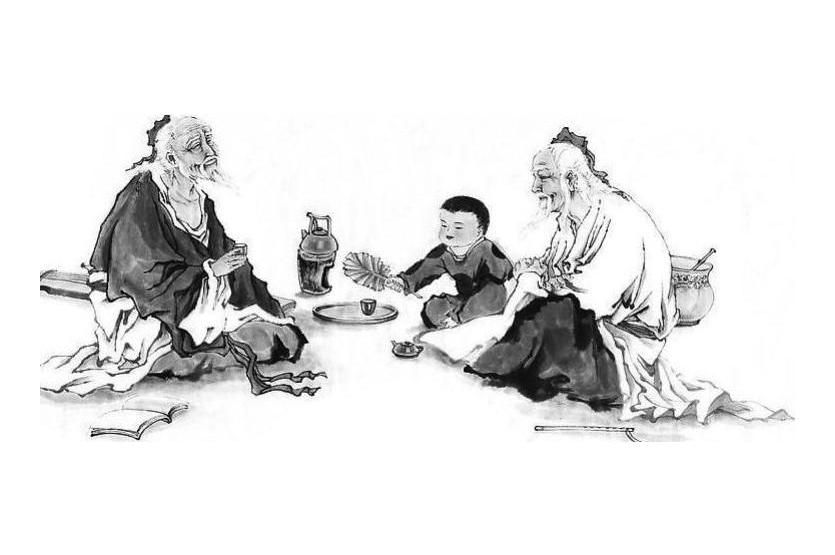Under the right circumstances, Chinese tea is more than just a practical beverage that keeps you warm and give you a mental boost. In a traditional tea ceremony, the tea artist greets you and shows you the tea leaves using her elegant movements. The sound of hot water being poured in the teapot resonates with calming background music of Chinese flute. The background noise of the world around you fades, and the little details of the tea ceremony become significant. You wonder: “Perhaps, life is about the small details…”
In this article, you'll learn how tea became a form of art from a historical perspective. We'll also answer important questions such as: What's the meaning and philosophy behind tea as a form of art? How is tea related to other art forms such as poetry, paintings and literature? How's tea represented in today's traditions and customs in China?
Chinese Tea: From Medicine to Art
Chinese tea wasn’t always a form of art. In early times, tea wasn’t steeped, but boiled. Farmers and soldiers drank the boiled tea to elevate fatigue, monks avoid drowsiness during long medication, and herbalists turn the tea into a paste to heal wounds.
Along the ancient tea horse trading routes from China’s Yunnan province, tea was pressed in round cakes and bricks to transport to nearby regions. In Tibet, tea was boiled with yak milk. It was considered an essential beverage to complement the greasy diet with a lack of fruit and vegetables. All in all, The purpose of tea was a practical one.
Chinese Tea in Poetry: Lu Tong
It wasn’t until the Tang Dynasty (618-907 ) for tea drinking to become an activity of pleasure and relaxation. Due to political stability and economic prosperity of the Tang period, Chinese culture flourished. This let to the rise of China’s most famous poets, Li bai, Du Fu and Lu Tong. The latter being especially famous for it’s tea poems, such as ‘The Seven Bowls of Tea’:
The first cup moistens the throat;
The second shatters all feelings of solitude;
The third cup purifies the digestion,
re-opening the five thousand volumes I’ve studied
and bringing them to mind afresh;
The fourth induces perspiration,
evaporating all of life’s trials and tribulations;
With the fifth cup, the body sharpens, crisp;
The sixth cup is the first step on the road to enlightenment;
And the seventh cup sits steaming—
it needn’t be drunk, as one is lifted to the abode of the immortals.
If you're interested in reading other tea poems, click on the links below:
Simmering Tea with Fresh River Water, Su Shi (Su Dongpo)
Chinese Tea in Paintings
Like poetry, tea also made its appearance in paintings. At first, tea was mainly a beverage enjoyed by the imperial court and nobles. For example, in the painting “Tuning the zither and sipping tea”, artist Zhou Fang shows that playing musical instruments and drinking tea is an important part of noble life.
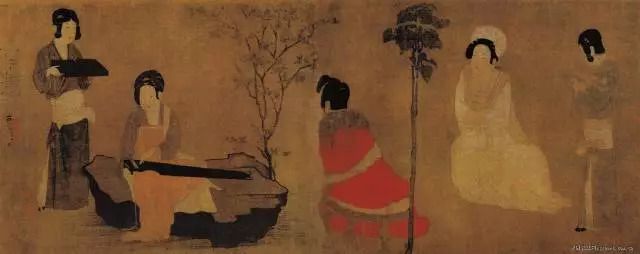
A noble woman is sitting on the rock, tuning a Chinese piano, a maid standing on the left, and two other noble women watching. The maid standing on the right is holding a tea bowl.
Slowly tea also became the beverage of choice among the middle class. A famous painting by Yan Liben, known as ‘Tea Competition’ (Dou Cha), vividly depicts the scene of folk having a tea competition in the Tang Dynasty.
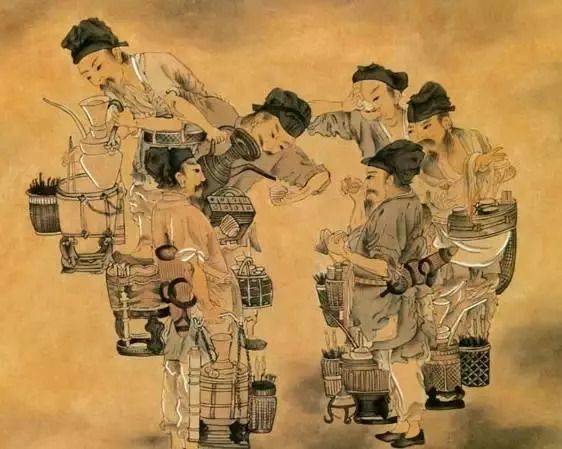
There are 6 figures in civilian costumes, each with a tea set, tea stove and tea next to them. They seem busy preparing, tasting, smelling and pouring tea, while some are at the same time listening to others that are boasting about their tea. The character and expression of the characters in the whole picture are vividly portrayed, which reproduces the scene of ‘Dou Cha’ in the Tang Dynasty.
It was during the Song Dynasty, in which tea culture made a significant transition from tea leaves to tea powder (‘mocha’). In the painting ‘Grinding Tea’ by Liu Song Nian during the Song Dynasty, we see a servant is sitting on a low table, rotating and grinding tea.
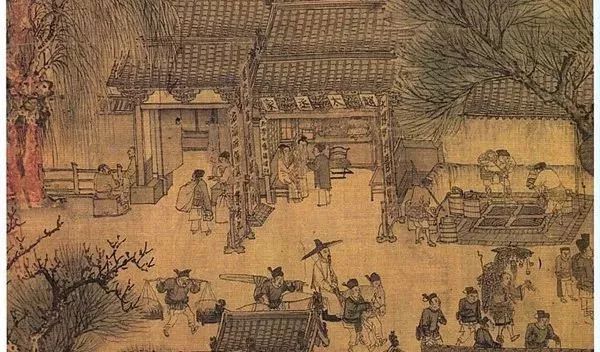
Chinese Tea in Literature: Lu Yu & Huizong
Lu Yu: Boiled Tea
Besides poems and paintings, the literary work from the Tang Dynasty also made contributions. By far the single most important work, is the ‘The Classic of Tea’ by Lu Yu. It was the first book on cultivating, preparing and drinking tea. His work earned him the title ‘the Sage of Tea’. Lu Yu’s most famous quote:
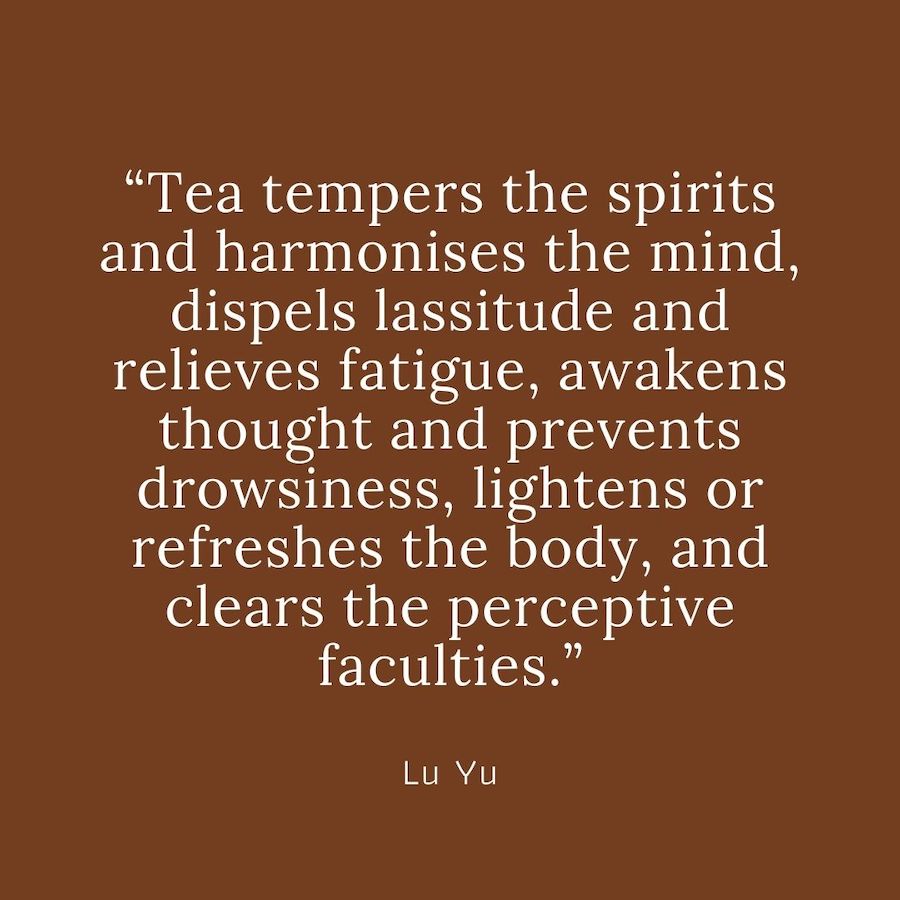
Poet Huangfu Zeng about Lu Yu
Poet Huangfu Zeng, who was a friend of Lu Yu, wrote a poem dedicated to Lu Yu:
The Day I Saw Lu Yu off to Pick Tea
A Thousand mountains will greet my departing friend,
When the spring teas blossom again
With such breadth and wisdom
Serenely picking tea
Through morning mists
or crimson evening cloud
His solitary journey is my envy
We meet at a remote mountain temple
Where we enjoy tea by a clear pebble fountain
In that silent night
Lit only by candlelight
I struck a marble bell
Its chime carrying me
A hidden man
Deep into thoughts of ages past.
by Huangfu Zeng
Huizong's Treatise of Tea: Whipped Tea
During the Tang Dynasty (618-907), people consumed tea cakes by loosening up leaves from the cake and boiling it in hot water. This resulted in a strong tasting tea. Starting in the Song Dynasty (960-1279), the concept of powdered tea came into fashion. Tea cakes are now grinded into powdered form and then whipped into a thick broth. In contrast to boiled tea, whipped tea is much thicker, smoother, and less astringent.
In Emperor Huizong’s ‘Treatise of Tea’ (Song Dynasty), he writes about the important aspects of growing, harvesting, preparing and enjoying tea. In his work, the process of grinding leaves as well as preparing tea with a whisk is also described in detail. Huizong's Treatise of Tea is therefore considered one of the most important pieces of work in the history of tea.
The Traditional Chinese Tea Ceremonies: Steeped Tea
Unfortunately, the culture of whipped tea was forgotten after the invasion of the Mongol tribes bringing an end to the Song dynasty. During the Ming Dynasty (1368 to 1644) tea was made by steeping loose tea leaves as we know it today. We call this 'steeped tea'. The reason the West only knows 'steeped tea' is because tea was first introduced in the seventeenth century to Europe, which was during the time of the Ming dynasty.
Whipped tea, fortunately continued to evolve in Japan (known as Matcha). The buddhist monk, Myoan Eisai, experienced the benefit of drinking whipped tea for his meditations. Thus he brought back powdered tea to Japan, were it eventually became popular.
In modern times, the traditional Chinese tea ceremony is also mainly based in the concept of 'steeped tea'. A tea ceremony is the most direct display Chinese tea culture. Tea artist prepares tea in a many carefully executed steps. The tea artist often times wears a traditional Chinese dress known as a ‘Qi Pao’ sitting behind a tea table or tray. She greets you, shows you the tea, and starts with heating and rinsing the teaware.
Chinese tea ceremonies are often accompanied with several tools, such a small spoon to shove the tea inside a teapot. The tea is always first transferred into a pitcher (gong dao bei) before it’s poured into cups. And depending on the kind of tea ceremony, a clipper may be used to move the tea cups from the tray to the audience.
The amount of steps and tools required depends on the the version of a tea ceremony one is performing. For example the traditional Chaozhou style tea ceremony consists of 21 steps. In Wuyishan tea ceremony even consists out of 27 steps:
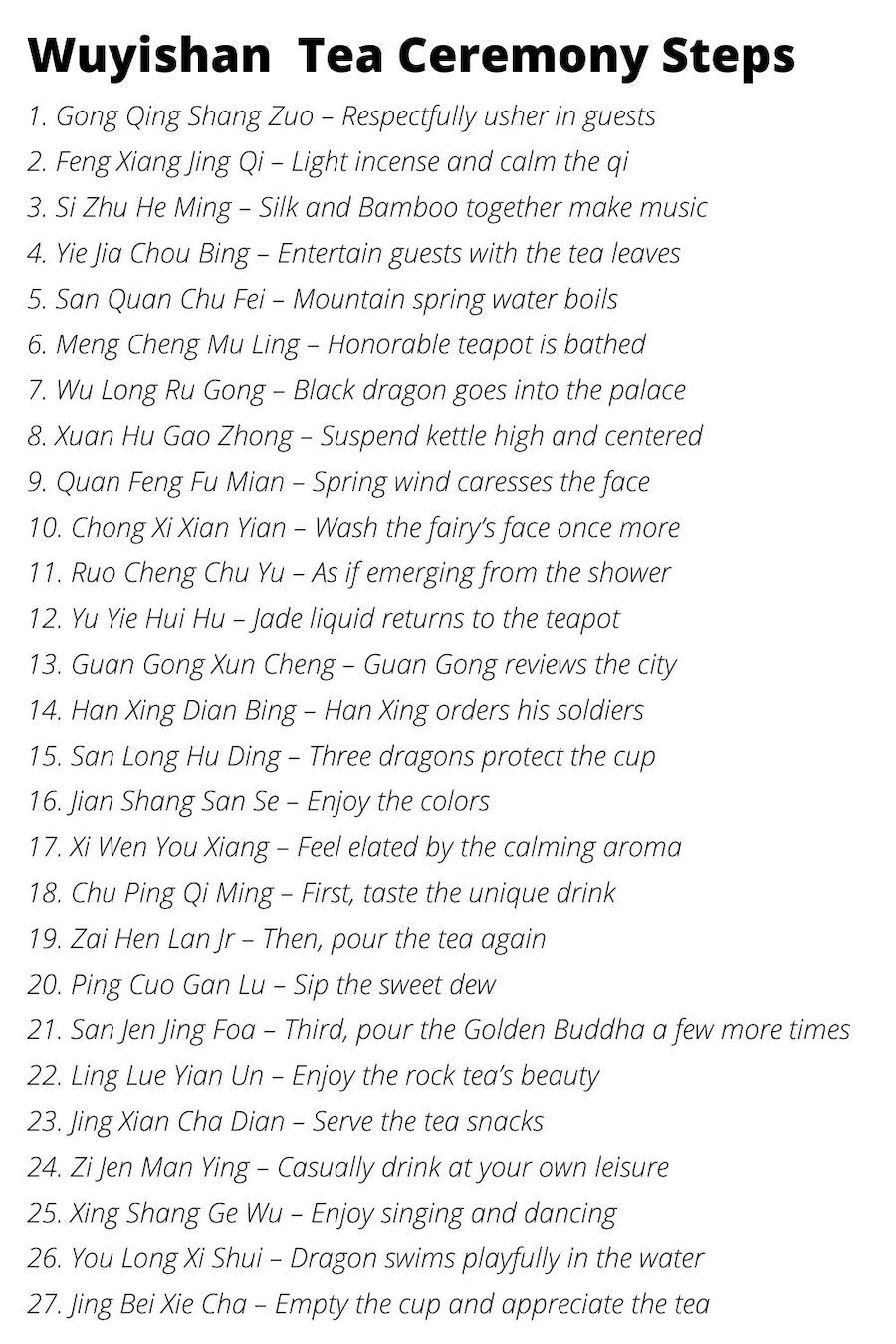
We believe this video, is a good display of the essence of a tea ceremony (though simplefied):
Tradition & Philosophy of Chinese Tea Art
Water
The sage of tea, Lu Yu, used to often time spend time on the country side and mountains to gather herbs and tea. During his travels, I discovered that Spring water allows the tea to taste much better. According to Lu Yu (The Classic of Tea), quote: "Spring water is the best, river water is second best, and well water is the worst."
Access to water: One has to remember that during his time, there was no tap water. It's therefore a no brainer that the closer you get to the source of water, the cleaner it is. In Modern times, depending on where you live, tap or bottled water can be a great alternative. One may also buy filters to alter the nature of tap water.
Water hardness: Another important aspect is water hardness. During Lu Yu's life (during the Tang Dynasty), boiled tea was still the standard. Boiled tea is strong and can handle the hardness of Spring water. However, some more subtle tasting steeped teas of today actually benefit from softer water.
Teaware
In the Tang Dynasty, ceramic teaware with light colours were preferred. White or light blue ceramic cups would allow one to appreciate the tea colour and even improve the natural green colour of the tea liquor.
However, during the Song Dynasty, people switched to powdered tea, whipped in a thick broth. Heavy and dark coloured black, brown and blue teaware were preferred at that time. These bowls are known as Jian Zhan bowls, such as this blue Jian Zhan cup.
In de Ming Dynasty, when steeped tea came into fashion, white porcelain was the standard for teaware.
Tea Competitions
Tea competitions were especially popular in the Song Dynasty (see the painting 'Dou Cha' by Yan Liben earlier in this article). In modern times, tea competitions are still a tradition in Wuyishan, Fujian. Locals compete on brewing the best cup of oolong tea. You may read more about this here: Wuyishan's Annual King of Tea Tournament.
Receiving Guests
In modern China, it's a traditional practice to serve tea when receiving guests. Tea is also a popular gift when visiting friends and family.
Wedding
At last, tea ceremonies are an essential part of today's modern Chinese weddings. Here's an in-depth article on this topic: Traditional Chinese Wedding Tea Ceremony.
Chinese Tea Religion
In China and other Asian countries, tea culture has always been closely related to religion. Monks in China have always favoured tea as a beverage. It keeps them alert while meditating, it helps digestion, and it calms the mind and suppresses desires. Monasteries in China have therefore not just became centres of tea consumption but also that of cultivation and promotion. Many monasteries experimented with growing their own tea trees and even invented many cultivars of tea.
Buddism, Taoism & Zenism
As Buddhism prospered during the Tang and Song Dynasty, the religion also became a medium to spread tea culture to the common people. Even monks from other Asian countries such as Japan and Korea, started to like the beverage and spread the words within their own countries.
During the Tang, another religion/philosophy known as ‘Daoism’ or ‘Taoism’ became popular. The Chinese traditional tea ceremony as we know today was developed through the translation of Taoist believes into the practice of tea. The term ‘Cha Dao’, which refers to the practice of tea, is in fact related to Daoism (‘Dao’ means ‘path’, while the ‘Cha Dao’ means ‘The Way of Tea’).
In the same way, it was Zenism (a different school of Buddhism), that influenced and shaped the Japanese tea ceremony.
We hope you enjoyed this article. For questions, feel free to leave a comment below!
